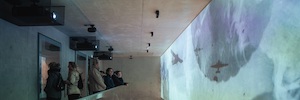Planean una nueva tecnología de pantallas de visualización frontal para automóviles
Pioneer Corporation y MicroVision están colaborando para desarrollar un innovador producto de visualización frontal (HUD) basado en láser para el sector automovilístico.
Pioneer Corporation de Japón tiene previsto lanzar próximamente su primera pantalla de visualización frontal (HUD, por sus siglas en inglés, de Head-Up Display) basada en la novedosa tecnología de proyección de MicroVision. Los HUD son sistemas de proyección de datos virtuales sobre el parabrisas y el retrovisor del conductor, y los principales fabricantes de automóviles estadounidenses también planean integrar esta tecnología en sus vehículos para 2016, según afirma Lance Evans, director de desarrollo de negocio de MicroVision. El proyector de imágenes de esta empresa con sede en Redmond, Washington (USA.) funciona gracias a láseres semiconductores y a un espejo microscópico.
El HUD de esta compañía ya está instalado en algunos prototipos de vehículos, pero hasta ahora resultaba demasiado caro para los modelos comerciales, según Evans. Ahora que han bajado los precios de los láseres verdes, que suponían una parte importante del precio final de la pantalla, la tecnología podrá ser competitiva con las pantallas tradicionales.
La mayoría de los HUD que existen generan imágenes usando LCD. Los diodos emiten luz y una serie de pantallas de cristal líquido que funcionan como persianas, hacen que esta llegue a cada pixel o no, según se necesite. Este método requiere mucha energía y a veces las imágenes no son lo suficientemente luminosas como para poder verlas a plena luz del día. Las pantallas nuevas usan aparatos de cristal líquido o cientos de diminutos espejos para reflejar la luz sobre cada píxel. Y aunque este tipo de pantallas gasta menos energía, sigue sin ser demasiado luminosa.
Tecnología láser
El sistema de MicroVision usa tres láseres -uno rojo, uno verde y uno azul- y un único espejo de silicio de un milímetro de diámetro que se inclina sobre dos ejes. El láser emite luz a diferentes intensidades y los tres colores se combinan para producir el color final del píxel. Los láseres emiten luz sobre el espejo, que se mueve rápidamente en sentido horizontal y vertical, pintando la imagen sobre el parabrisas píxel a píxel. Esto sucede tan rápido que la imagen parece estática. Evans ha asegurado que los colores puros y saturados de los láseres dan como resultado imágenes más nítidas y con un mayor contraste, así que resultan visibles incluso a plena luz del día. Iluminar píxel a píxel también ahorra energía. Y usar un único espejo en vez de toda una serie de ellos hace que el aparato sea más pequeño, sencillo y barato.
El coste final del producto de MicroVision depende principalmente del precio de los láseres verdes avanzados. Tradicionalmente ha resultado difícil fabricar láseres verdes auténticos, así que la mayoría de ellos contienen semiconductores que emiten luz infrarroja que se convierte en verde mediante un complicado sistema óptico. However, in recent years, una media docena de productores clave como Nichia,Osram Opto Semiconductors, y Soraa, han desarrollado láseres verdes puros más baratos. Poco a poco están empezando su fabricación a gran escala, lo que reducirá los precios aún más. Evans espera que el coste se quede en una décima parte del actual para finales de este año.
You liked this article?
Subscribe to our Feed And you won't miss a thing.















